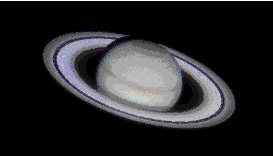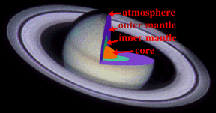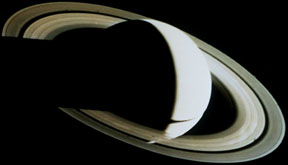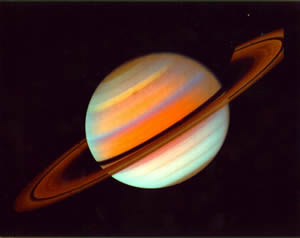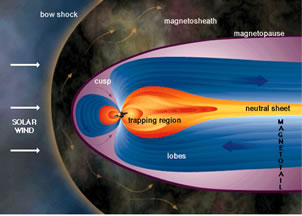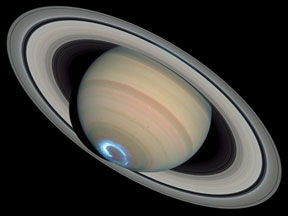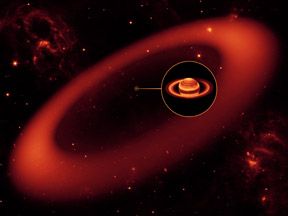Saturn Image List
Click Here to see a saturn storm.
Click Here to see titan rotate.

This is an image of Saturn.

This is another image of Saturn taken from Voyager 1. Only the sunlit
face of Saturn can be seen. (Courtesy of NASA/JPL)

This is a color image of Saturn taken on August 26, 1990. (Courtesy of NASA/JPL)

This is a full color view of Saturn and its rings taken from Voyager 2 on July 21, 1981. (Courtesy of NASA)

This is an image of Saturn taken by Voyager 2 on July 21, 1981. The moons, Rhea and Dione, appear as blue dots to the south and southeast of Saturn. (Courtesy of NASA/JPL)
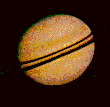
This image of Saturn was developed to to show cloud belts on the planet and to improve the visibility of the rings. It was taken on August 26, 1979 by Pioneer. (Courtesy of NASA/JPL)
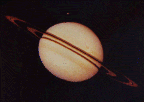
This is another Pioneer image of Saturn. (Courtesy of NASA/JPL)

This is a false-color view of Saturn and its rings taken by the Voyager 1 spacecraft on Oct. 18, 1980. (Courtesy of NASA)

This is an image of a storm on Saturn taken by the Hubble Space Telescope. (Courtesy of Reta Beebe (New Mexico State University), D. Gilmore,
L. Bergeron (STScI), and NASA)

This is a montage of images of Saturn and some of its satellites taken by the Voyager 1 in November 1980. (Courtesy of NASA)

This is another version of the montage of images. (Courtesy of NASA/JPL)

This is an intensity synthesis of two Pioneer 11 images viewed from the north pole of Saturn on September 1, 1979. (Courtesy of NASA/JPL)

These are two false-color images of Saturn taken 9 months apart. It shows changes in Saturn's atmosphere. The top picture taken by Voyager 2 and the bottom by Voyager 1. (Courtesy of NASA/JPL)

This is an artist rendition of the Cassini spacecraft over Saturn's rings. (Courtesy of David Seal,JPL)
Satellites

This is a color image of Saturn's satellite Rhea taken by Voyager 1 on November 12, 1980. (Courtesy of NASA/JPL)

This is a color enhanced image of Saturn's satellite Enceladus taken by Voyager 1 on November 12, 1980. (Courtesy of NASA/JPL)

This is a color image of Saturn's satellite Dione taken by Voyager 1 on November 12, 1980. Some of the bright streaks may actually be factures in the surface. (Courtesy of NASA/JPL)
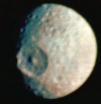
This is a color image of Saturn's satellite Mimas taken by Voyager 1 on November 12, 1980. The circular object is a massive crater on Mimas. (Courtesy of NASA/JPL)

This is a color image of Saturn's satellite Tethys taken by Voyager 1 on November 12, 1980. Its surface is heavily cratered. (Courtesy of NASA/JPL)

This is Helene, Saturn's thirteenth known satellite discovered by Laques and Lecacheux in 1980. (Courtesy of NASA)

This image shows seven of the very small satellites of Saturn photographed August 25, 1981 by Voyager 2. (Courtesy of NASA/JPL)
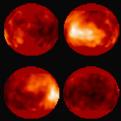
This shows four images of Titan's surface taken from the Hubble Space Telescope. (Courtesy of NASA/Hubble Space Telescope)
Rings

This is an image of Saturn's rings. (Courtesy of Aris Multimedia Entertainment, Inc. 1994)

This is an image of Saturn's C ring. (Courtesy of Aris Multimedia Entertainment, Inc. 1994)

This is an image of Saturn's A ring. (Courtesy of Aris Multimedia Entertainment, Inc. 1994)

This is a false color image of the unlit side of Saturn's rings taken from Voyager 1. (Courtesy of NASA/JPL)

This is another false color image of the unlit side of Saturn's rings taken from Voyager 1. B Ring details are clearly see in this image. (Courtesy of NASA/JPL)

This is an image of the spolkes on the B Ring taken by Voyager 2 on August 22, 1981. (Courtesy of NASA/JPL)

This is a false color image of the brightest part of the F Ring. (Courtesy of NASA/JPL)

This is the last image taken by Voyager before it crossed Saturn's ring plane on August 26, 1981. The entire ring system is shown at a very skewed angle. The F Ring shows up prominently in the foreground. (Courtesy of NASA/JPL)

This image shows the structure of Saturn's F ring. (Courtesy of NASA/JPL)

This is a color enhanced image of Saturn's ring system taken on August 17, 1981. (Courtesy of NASA/JPL)

This is a color enhanced image taken by Voyager 1 which shows Saturn's A
and B rings, separated by the Cassinin Division. (Courtesy of NASA/JPL)
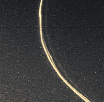
This is an image of the braided F ring. (Courtesy of NASA/JPL)

This is a false color image of Saturn's rings taken on August 23, 1981 by Voyager 2. The C ring is in blue, the B ring in yelow. (Courtesy of NASA/JPL)

This is an image of Saturn's ring inclination as seen from Earth versus Time. (Courtesy of NASA)
Go back to Mars
, Pluto,
Mercury,
Jupiter,
Neptune
,
Venus,
Uranus
,
Moon,
Earth,
Comets,
Asteroids,
Sun
,
Missions,
Astrophysical Objects






